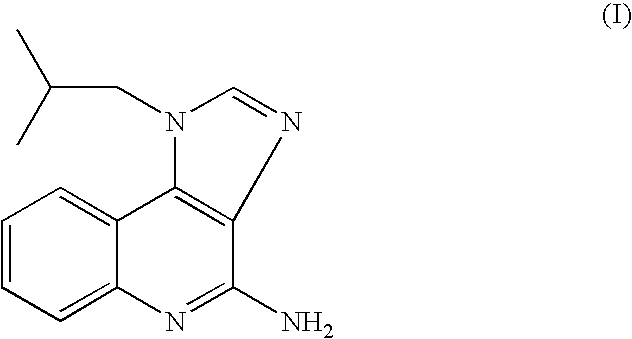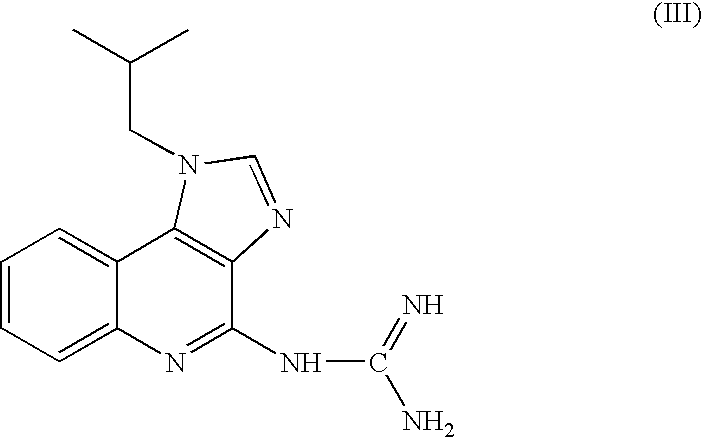Imiquimod Production Process
a technology of imiquimod and production process, applied in the direction of organic chemistry, etc., can solve the problems of unattractive industrial implementation process, unsatisfactory industrial safety measures, and long process
- Summary
- Abstract
- Description
- Claims
- Application Information
AI Technical Summary
Benefits of technology
Problems solved by technology
Method used
Image
Examples
example 1
[0068]This example illustrates an exemplary process for preparing imiquimod by reaction of compound II with 10 equivalents of urea in DMSO at 135-140° C.
[0069]A mixture of 4-chloro-1-isobutyl-1H-imidazo[4,5-c]quinoline (II) (3 g, 0.0116 mol), urea (6.9 g, 0.116 mol, 10 equiv.) and DMSO (20 ml) was heated under stirring at 140° C. for 35 hours. Then, the reaction mixture was cooled to 80° C. and water (30 ml) and 46% aqueous NaOH solution were added to produce a pH of 10-11. The mixture was stirred at ambient temperature for 1 hour and a precipitate was collected by filtration. The wet compound was treated with water (20 ml) at 70-80° C. under stirring for 1 hour. A solid was collected by filtration from the hot mixture, washed with water (3×20 ml) and methanol (20 ml) and dried at 80° C. under reduced pressure overnight to yield 2.4 g of crude Imiquimod in 87.6% yield, having 99.0% purity (by HPLC, containing 1.0% of compound II).
[0070]A mixture of the crude product (2.4 g) and DMSO...
example 2
[0071]This example illustrates an exemplary process for preparing imiquimod by reaction of compound II with 20 equivalents of urea in DMSO at 155-160° C.
[0072]A mixture of 4-chloro-1-isobutyl-1H-imidazo[4,5-c]quinoline (II) (3 g, 0.0116 mol), urea (13.8 g, 0.232 mol, 20 equiv.) and DMSO (25 ml) was heated under stirring at 155-160° C. for 12 hours. Then, the reaction mixture was cooled to 80° C. and water (30 ml) and 46% aqueous NaOH solution were added to produce a pH of 10-11. The mixture was stirred at ambient temperature for 1 hour and a precipitate was collected by filtration. The wet compound was treated with water (20 ml) at 70-80° C. under stirring for 1 hour. A solid was collected by filtration from the hot mixture, washed with water (3×20 ml) and methanol (20 ml) and dried at 80° C. under reduced pressure overnight to yield 2.45 g of crude imiquimod in 88.5% yield, having a purity of 99.0% (by HPLC, containing 1.0% of the compound II). The crude imiquimod was purified by t...
example 3
[0073]This example illustrates an exemplary process for preparing imiquimod by reaction of compound II with 20 equivalents of urea in DMSO at 145-150° C.
[0074]A mixture of 4-chloro-1-isobutyl-1H-imidazo[4,5-c]quinoline (II) (4 g, 0.0154 mol), urea (18.5 g, 0.308 mol, 20 equiv.) and DMSO (26 ml) was heated under stirring at 145-150+C for 24 hours. Then, the reaction mixture was cooled to 80° C. and water (52 ml) and 46% aqueous NaOH solution were added to produce a pH of 10-11. The mixture was stirred at ambient temperature for 1 hour and a precipitate was collected by filtration. The wet compound was treated with water (25 ml) at 70-80° C. under stirring for 1 hour. A solid was collected by filtration from the hot mixture, washed with water (3×20 ml) and methanol (20 ml) and dried at 80° C. under reduced pressure overnight to yield 3.13 g of crude imiquimod in 84.8% yield, having a purity of 99.4% by HPLC, (containing 0.6% of the compound II). The crude imiquimod was purified by the...
PUM
| Property | Measurement | Unit |
|---|---|---|
| temperature | aaaaa | aaaaa |
| temperature | aaaaa | aaaaa |
| temperature | aaaaa | aaaaa |
Abstract
Description
Claims
Application Information
 Login to View More
Login to View More - R&D
- Intellectual Property
- Life Sciences
- Materials
- Tech Scout
- Unparalleled Data Quality
- Higher Quality Content
- 60% Fewer Hallucinations
Browse by: Latest US Patents, China's latest patents, Technical Efficacy Thesaurus, Application Domain, Technology Topic, Popular Technical Reports.
© 2025 PatSnap. All rights reserved.Legal|Privacy policy|Modern Slavery Act Transparency Statement|Sitemap|About US| Contact US: help@patsnap.com



